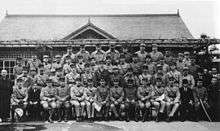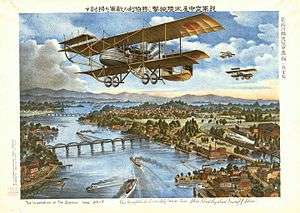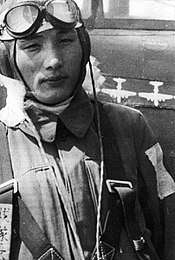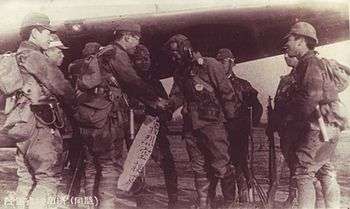Imperial Japanese Army Air Service
The Imperial Japanese Army Air Service or Imperial Japanese Army Air Force (IJAAS or IJAAF) (大日本帝國陸軍航空部隊, Dainippon Teikoku Rikugun Kōkūbutai) or, more literally, the Greater Japan Empire Army Air Corps, was the aviation force of the Imperial Japanese Army (IJA). Just as the IJA in general was modeled mainly on the German Army, the IJAAS initially developed along similar lines to the Imperial German Army Aviation; its primary mission was to provide tactical close air support for ground forces, as well as a limited air interdiction capability. The IJAAS also provided aerial reconnaissance to other branches of the IJA. While the IJAAS engaged in strategic bombing of cities such as Shanghai, Nanking, Canton, Chongqing, Rangoon, and Mandalay, this was not the primary mission of the IJAAS, and it lacked a heavy bomber force.
| Imperial Japanese Army Air Service (IJAAS) | |
|---|---|
| 大日本帝國陸軍航空部隊 Dainippon Teikoku Rikugun Kōkūbutai | |
.svg.png) | |
| Active | 1912–1945 |
| Country | |
| Allegiance | Ministry of the Army Inspectorate General of Aviation |
| Branch | |
| Type | Air force |
| Role | Aerial warfare |
| Part of | Armed Forces of the Empire of Japan |
| Engagements | World War I Mukden Incident Sino-Japanese War Battles of Khalkhin Gol World War II |
| Commanders | |
| Ceremonial chief | |
| Notable commanders | Hajime Sugiyama Prince Naruhiko Higashikuni Shunroku Hata Masakazu Kawabe |
| Insignia | |
| Roundel | .svg.png) |
It did not usually control artillery spotter/observer aircraft; artillery battalions controlled the light aircraft and balloons that operated in these roles.
The Imperial Japanese Navy Air Service was responsible for long-range bomber and attack aircraft, as well as strategic air defense. It was not until the later stages of the Pacific War that the two air arms attempted to integrate the air defense of the home islands.
History
Origins

The Imperial Japanese Army made use of hydrogen balloons for observation purposes in the Russo-Japanese War of 1904-1905[1] and in 1909, together with the Imperial Japanese Navy and the Tokyo Imperial University, the Rinji Gunyo Kikyu Kenkyukai (Temporary Military Balloon Research Association) was set up.[1] In 1910, the society sent Captain Yoshitoshi Tokugawa and Captain Hino Kumazō to France and Germany, respectively, to receive pilot training and purchase aircraft.[2] Japan purchased its first aircraft, a Farman biplane and a Grade monoplane, which had been brought back by the officers from Western Europe.[2] On December 19 1910, Captain Yoshitoshi Tokugawa in a Farman III conducted the first successful powered flight on Japanese soil at Yoyogi Parade Ground in Tokyo.[1] The following year in 1911, several more aircraft were imported and an improved version of the Farman III biplane, the Kaishiki No.1, was built and flown in Japan by Captain Togugawa.[2] In 1914, with the outbreak of war, the Japanese laid siege to the German colony of Tsingtao, aircraft from the army together with the navy conducted reconnaissance and bombing operations. The Provisional Air Corps consisting of four Maurice Farman MF.7 biplanes and a single Nieuport VI-M monoplane flew 86 sorties between them.[3] In December 1915, a air battalion was created under the Army Transport Command, which became responsible for all air operations.[4] However, serious interest in military aviation did not develop until after World War I. Japanese military observers in Western Europe were quick to spot the advantages of the new technology, and after the end of the war, Japan purchased large numbers of surplus military aircraft, including Sopwith 1½ Strutters, Nieuport 24s, and Spads.
Interwar Years

In 1918, a French military mission was invited to Japan to help develop aviation. The mission was headed by Jacques-Paul Faure and composed of 63 members to establish the fundamentals of the Japanese aviation, the mission also brought several aircraft including Salmson 2A2, Nieuport, Spad XIII, two Breguet XIV, as well as Caquot dirigables.[4] Japanese army aviation was organized into a separate chain of command within the Ministry of War of Japan in 1919, and aircraft were being used in combat roles during the 1920 Siberian Intervention against the Bolshevik Red Army near Vladivostok. The first aircraft factory in Japan, Nakajima Aircraft Company, was founded in 1916 and later obtained a license to produce the Nieuport 24 and Nieuport-Delage NiD 29 C.1 (as the Nakajima Ko-4) as well as the Hispano-Suiza engine. Nakajima later license-produced the Gloster Sparrowhawk and Bristol Jupiter. Similarly, Mitsubishi Heavy Industries started producing aircraft under license from Sopwith in 1921, and Kawasaki Heavy Industries started producing the Salmson 2 A.2 bomber from France, and hired German engineers such as Dr. Richard Vogt to produce original designs such as the Type 88 bomber. Kawasaki also produced aircraft engines under license from BMW. In May 1925, the Imperial Japanese Army Air Corps was established under the command of Lieutenant General Kinichi Yasumitsu, it was regarded as a branch equal to the artillery, cavalry or infantry,[4] and contained 3,700 personnel with about 500 aircraft.[4]
By the end of the 1920s, Japan was producing its own designs to meet the needs of the Army, and by 1935 had a large inventory of indigenous aircraft designs that were technically sophisticated.
By 1941, the Japanese Army Air Force had about 1,500 combat aircraft. During the first years of the war, Japan continued technical development and deployment of increasingly advanced aircraft and enjoyed air superiority over most battlefields due to the combat experience of its crews and the handling qualities of its aircraft.
However, as the war continued, Japan found that its production could not match that of the Allies. On top of these production problems, Japan faced continuous combat and thus continued losses. Furthermore, there were continual production disruptions brought on by moving factories from location to location, each transfer with the goal of avoiding the Allied strategic bombing. Between these factors and others, such as the restricted strategic materials, the Japanese found themselves materialistically outmatched.
In terms of manpower, Japan was even worse off. Experienced crews were killed and replacements had not been planned. The Japanese had lost skilled trainers, and they did not have the fuel or the time to use the trainers they did have. Because of this, towards the end of its existence the JAAF resorted to kamikaze attacks against overwhelmingly superior Allied forces.
| Imperial Japanese Military |
|---|
.svg.png) |
| Administration |
|
(Dai Nippon Teikoku Rikugun) |
|
(Dai Nippon Teikoku Kaigun) |
|
| Rank insignia |
| History |
|

World War II Aircraft
Important aircraft used by the Imperial Japanese Army Air Force during the Second Sino-Japanese War and World War II were:
Fighters:
- Nakajima Ki-27 中島 キ27 九七式戦闘機 (Type 97 Fighter) Nate
- Nakajima Ki-43 中島 キ43 一式戦闘機 隼 (Type 1 Fighter "Hayabusa") Oscar
- Nakajima Ki-44 中島 キ44 二式戦闘機 鍾馗 (Type 2 Fighter "Shōki") Tojo
- Kawasaki Ki-45 Kai 川崎 キ45改 二式複座戦闘機 屠龍 (Type 2 Two-seat Fighter "Toryū") Nick
- Kawasaki Ki-61 川崎 キ61 三式戦闘機 飛燕 (Type 3 Fighter "Hien") Tony
- Nakajima Ki-84 中島 キ84 四式戦闘機 疾風 (Type 4 Fighter "Hayate") Frank
- Kawasaki Ki-100 川崎 キ100 五式戦闘機 (Type 5 Fighter)
- Mitsubishi Ki-109 三菱 キ109 試作特殊防空戦闘機 (Experimental heavy fighter interceptor)
Bombers:
- Mitsubishi Ki-21 三菱 キ21 九七式重爆撃機 (Type 97 Heavy Bomber) Sally
- Mitsubishi Ki-30 三菱 キ30 九七式軽爆撃機 (Type 97 Light Bomber) Ann
- Kawasaki Ki-32 川崎 キ32 九八式軽爆撃機, (Type 98 Light Bomber) Mary
- Kawasaki Ki-48 川崎 キ48 九九式双軽爆撃機 (Type 99 Twin-engined Light Bomber) Lily
- Nakajima Ki-49 中島 キ49 一〇〇式重爆撃機 呑龍 (Type 100 Heavy Bomber "Donryū") Helen
- Mitsubishi Ki-67 三菱 キ67 四式重爆撃機 飛龍 (Type 4 Heavy Bomber "Hiryū") Peggy
Forward air control aircraft:
- Mitsubishi Ki-51 三菱 キ51 九九式襲撃機 (Type 99 Assault plane) Sonia
- Kawasaki Ki-102 川崎 キ102 五式双発襲撃機 (Type 5 Twin-engined Assault plane) Randy
Transports:
- Nakajima Ki-34 中島 キ34 九七式輸送機 (Type 97 Transporter) Thora
- Mitsubishi Ki-57 三菱 キ57 一〇〇式輸送機 (Type 100 Transporter) Topsy
- Kawasaki Ki-56 川崎 キ56 一式貨物輸送機 (Type 1 Cargo aircraft) Thalia
- Kokusai Ki-59 国際 キ59 一式輸送機 (Type 1 Transporter) Theresa
Reconnaissance Planes:
- Mitsubishi Ki-15 三菱 キ15 九七式司令部偵察機 (Type 97 Army HQ Reconnaissance plane) Babs
- Tachikawa Ki-36 立川 キ36 九八式直協偵察機 (Type 98 Reconnaissance plane) Ida
- Mitsubishi Ki-51 三菱 キ51 九九式軍偵察機 (Type 99 Reconnaissance plane) Sonia
- Mitsubishi Ki-46 三菱 キ46 一〇〇式司令部偵察機 (Type 100 Army HQ Reconnaissance plane) Dinah
Trainers:
- Tachikawa Ki-9 立川 キ9 九五式一型練習機 (Type 95 Model 1 Intermediate trainer) Spruce
- Tachikawa Ki-17 立川 キ17 九五式三型練習機 (Type 95 Model 3 Basic trainer) Cedar
- Tachikawa Ki-55 立川 キ55 九九式高等練習機 (Type 99 Advanced trainer) Ida
- Tachikawa Ki-54 立川 キ54 一式双発高等練習機 (Type 1 Twin-engine advanced trainer) Hickory
- Manshū Ki-79 満州 キ79 二式高等練習機 (Type 2 Advanced trainer)
- Kokusai Ki-86 国際 キ86 四式基本練習機 (Type 4 Basic trainer) Cypress
Other planes:
- Kokusai Ki-76 国際 キ76 三式指揮連絡機 (Type 3 Command-control/Liaisonal plane) Stella
- Kayaba Ka-1 萱場 カ号観測機 (Ka-Gō Artillery-spotter)
Organization
Army Aeronautical Department Sections
- Commander-in-Chief of Army Air Service Office
- Air Service Staff Department
- General Affairs and Administrative Department
- Inspectorate General of Aviation
- General Affairs Unit of Inspectorate of Army Aviation
- Air Training and Instruction Department
- Imperial Japanese Army Air Service Academy
- Supply Bureau
- Tachikawa Army Air Arsenal
- Army Air Transport Department
- Army Air Intelligence Department
Operational Organization
Before World War I, the basic unit of the Army Air Service was the Air Battalion (航空大隊, Kōkū Daitai), each consisting of two squadrons (中隊, Chutai) with nine aircraft each, plus three reserve aircraft and three earmarked for use by the headquarters, for a total of 24 aircraft per battalion. The officer commanding the chutai was the Chutaicho, whose rank was usually that of captain. The commander's aircraft often had distinctive markings, often a partly or totally scarlet, red, orange or yellow tail.
In a reorganization of 1927-05-05, the Air Regiment (飛行連隊, Hikō Rentai) was created, each consisting of two battalions, with each battalion consisting of up to four squadrons. Each Air Regiment was a mixed purpose unit, consisting of a mixture of fighter and reconnaissance squadrons.
With the start of the Second Sino-Japanese War in 1937, operational conditions favored the use of many small units, resulting in the creation of many independent Air Battalions (独立飛行大隊, Dokuritsu Hikō Daitai) or even independent squadrons (独立飛行中隊, Dokuritsu Hikō Chutai), each with its own distinctive markings.
In August 1938, a complete re-organization of the Army Air Service resulted in the creation of the Air Combat Group (飛行戦隊, Hikō Sentai), which replaced all of the former Air Battalions and Air Regiments. Each Air Combat Group was a single-purpose unit consisting typically of three Squadrons, divided into three flights (小隊, shōtai) of three aircraft each. Together with reserve aircraft and the headquarters flight, an Air Combat Group typically had 45 aircraft (fighter) or up to 30 aircraft (bomber or reconnaissance). Two or more Air Combat Groups formed an Air Division (飛行団, Hikōdan), which, together with base and support units and a number of Independent Squadrons, formed an Air Corps (飛行集団, Hikō Shudan).
In 1942, the Air Corps were renamed Air Divisions (飛行師団, Hikō Shidan), to mirror the terminology for infantry divisions, but the structure remained the same. Two Air Divisions, together with some independent units made an Air Army (航空軍, Kōkū gun).
Throughout most of the Pacific War, the Japanese Army Air Service was organized into four Air Armies, with two more added in the final stages of the war:
- 1st Air Army – HQ Tokyo, basing in the Kanto Plain covering the Japanese home islands, Taiwan, Korea, Chishima, and Karafuto.
- 2nd Air Army - HQ Hsinking, covering Manchukuo
- 3rd Air Army - HQ Singapore, covering Southeast Asia
- 4th Air Army - HQ Rabaul, covering the Solomon Islands and New Guinea
- 5th Air Army - HQ Nanking, covering Japanese-occupied portions of southern and eastern China.
- 6th Air Army – on Kyūshū covering Taiwan and Okinawa
In April 1944, a reorganization of the Japanese Army Air Service occurred. Maintenance and ground service units, formerly a separate command, were merged into the Air Combat Group (Hiko Sentai). The flying squadrons of the Air Combat Group were re-designated as Squadron (飛行隊, Hikōtai), and the ground units were designated Maintenance Units (整備隊, Seibutai).
Other changes in the final stages of the war was the formation of "Special Attack Units" and "Air-shaking Units", which were short-lived units with their own names (often taken from Japanese mythology or history) and markings, but located within existing squadrons. These units were specially designated and trained with the mission of air-to-air ramming of Allied bomber aircraft. They usually had their armaments removed and their airframes reinforced.
In the final phase of the war, the Special Attack Units evolved into dedicated suicide units for kamikaze missions. Around 170 of these units were formed, 57 by the Instructor Air Division alone. Notionally equipped with 12 aircraft each, it eventually comprised around 2000 aircraft.
The final reorganisation of the took place during preparation for Operation Ketsu-Go, the defence of the home islands in 1945 when all the Air Armies were combined under a centralised command of General Masakazu Kawabe .[5]
Special Operations Forces
Teishin Shudan ("Raiding Group") was the IJA's special forces/airborne unit during World War II. The word teishin may be literally translated as "dash forward", and is usually translated as "raiding". It may also be regarded as similar to the "commando" designation in the terminology of other armies. Called a division, the unit was a brigade-sized force, and was part of the Imperial Japanese Army Air Service (IJAAS). The Teishin units were therefore distinct from the marine parachute units of the Special Naval Landing Forces.

'Giretsu' (義烈空挺隊, Giretsu Kūteitai) was an airborne special forces unit of the Imperial Japanese Army formed from Army paratroopers, in late 1944 as a last-ditch attempt to reduce and delay Allied bombing raids on the Japanese home islands. The Giretsu Special Forces unit was commanded by Lieutenant General Kyoji Tominaga.
Strength
In 1940 the Japanese Army Air Service consisted of the following:
- 33,000 personnel
- Over 1,600 aircraft (including 1,375 first line combat aircraft).
- The aircraft were organized into 85 Squadrons;
- 36 fighter
- 28 light bomber
- 22 medium bomber
- Total military in August 1945 was 6,095,000 including 676,863 Army Air Service.
First Tachikawa Army Air Arsenal
The Japanese Air Army Force had one technical section, the First Tachikawa Air Army Arsenal, which was in charge of aviation research and development. The Arsenal included a testing section for captured Allied aircraft, the Air Technical Research Laboratory (Koku Gijutsu Kenkyujo).
The Army Air Arsenal was also connected with Tachikawa Hikoki K.K. and Rikugun Kokukosho K.K., the Army-owned and operationed aircraft manufacturing companies. much as the IJNAS operated its own firm, the Yokosuka Naval Air Technical Arsenal.
Army Escort-Aircraft Carriers
Due to the poor relations between the Imperial Japanese Army and Imperial Japanese Navy, the Army found it necessary to procure and operate their own aircraft carriers for the purposes of providing escort and protection for Army transport shipping convoys. These escort/transport carriers were converted from small passenger liners or merchant ships and possessed the capacity to operate from eight to 38 aircraft, depending on type and size, and were also used to transport personnel and tanks.
These vessels included the Taiyō Maru, Unyo Maru, Chuyo Maru, Kaiyō Maru, Shinyo Maru, Kamakura Maru, Akitsu Maru, Nigitsu Maru, Kumano Maru, Yamashiro Maru, Shimane Maru, Chigusa Maru (not completed), and Otakisan Maru (not completed) and were operated by civilian crews with Army personnel manning the light and medium anti-aircraft guns.
Uniforms and equipment
As an integral part of the IJA, the Army Air Service wore the standard Imperial Japanese Army Uniforms. Only flying personnel and ground crews wore sky blue trim and stripes, while officers wore their ranks on sky blue patches.
See also
- List of military aircraft of Japan
- Giretsu special forces
- Teishin Shudan (Army air service airborne/commando division)
- Hikōtai Transport Unit
- Kōkūtai
- Inspectorate General of Aviation
- List of Radars in use by Imperial Japanese Army
- List of Bombs in use by Imperial Japanese Army
- List of weapons on Japanese combat aircraft
- List of Aircraft engines in use of Japanese Army Air Force
- List of foreign aircraft tested by Japanese forces from 1930s to WW2
- List of Japanese trainer aircraft during World War II
- Japanese military aircraft designation systems
- Imperial Japanese Army Air Academy
- Air raids on Japan
References
- Hata, Izawa & Shores 2012, p. 1.
- Francillon 1979, p. 29.
- Stephenson 2017, p. 96.
- Francillon 1979, p. 30.
- p.107, Skates
Bibliography
- Francillon, René J (1979). Japanese Aircraft of the Pacific War (2nd edition). London, UK: Putnam & Company Ltd. ISBN 0-370-30251-6.CS1 maint: ref=harv (link)
- Hata, Ikuhiko; Izawa, Yashuho; Shores, Christopher (2002). Japanese Army Air Force Units and Their Aces: 1931-1945. London: Grub Street. ISBN 1-902304-89-6.
- Hata, Ikuhiko; Izawa, Yashuho; Shores, Christopher (2012). Japanese Army Fighter Aces: 1931-45. Stackpole Military History Series. London, UK: Stackpole Books. ISBN 1-461-75118-7.CS1 maint: ref=harv (link)
- Mayer, S.L. (1976). The Rise and Fall of Imperial Japan. The Military Press. ISBN 0-517-42313-8.
- Sakaida, Henry (1997). Japanese Army Air Force Aces, 1937-1945. Botley, Oxfordshire, UK: Osprey Publishing. ISBN 1-85532-529-2.
- Skates, John Ray. The Invasion of Japan: Alternative to the Bomb. Columbia, South Carolina, USA: University of South Carolina Press, 1994. ISBN 0-87249-972-3.
- Stephenson, Charles (2017). The Siege of Tsingtau: The German-Japanese War 1914. Pen and Sword. ISBN 1-52670-295-9.CS1 maint: ref=harv (link)
External links
- An introduction to the Japanese Army Air Force
- Images of Axis aircraft: German, Italian and Japanese Army and Navy
- Advanced Japanese aircraft
- General resources on Japanese aircraft
- Some captured aircraft, or aircraft in evaluation
- Japanese armaments, vehicles, aircraft, electronic warfare and some Japanese special weapon technology
- Mark Kaiser, 1997-98, "Unit structure of IJA Air Force" (self-published)